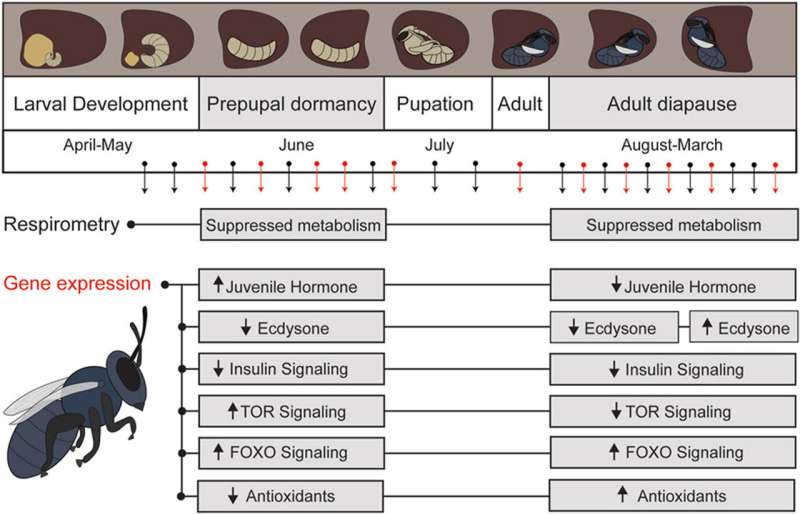This article has been reviewed according to Science X's editorial process and policies. Editors have highlighted the following attributes while ensuring the content's credibility:
fact-checked
trusted source
proofread
Scientists gain insight into a buzzing spring pollinator that plays a significant role in the almond industry

The USDA's Agricultural Research Service (ARS), in collaboration with the Ecological Forestry Applications Research Centre in Spain and North Dakota State University, have conducted a comparison of the physiological and molecular processes involved in the summer and winter dormancy of Osmia lignaria, also known as blue orchard bee or orchard mason bee.
The research is published in the journal Insect Biochemistry and Molecular Biology.
This analysis of gene expression is believed to be the first to compare the dormancy periods of this species in their natural habitat, and more importantly, it has led to sequencing the first draft genome of this important pollinator for the almond industry.
According to the U.S. Forest Service, North America has 140 species of Osmia. Osmia lignaria, a solitary bee, follows a one-year life cycle that includes two periods of dormancy. During summer, the bee develops to the prepupal stage (the stage of larva after its final molt), pauses, then finishes to developing to the adult stage before winter.
Adult bees slow their metabolic activity while overwintering [second dormancy]. When spring arrives, adult bees emerge from dormancy and become highly active in pollination. Although this species does not produce honey, it is very effective in pollinating almond trees due to cross-pollination among different varieties, which leads to higher crop yields.
"This species inhabits a wide latitudinal range in North America, with populations in the north having different developmental rates and lengths of dormancy periods than those in southern populations," said Alex Torson, a computational biologist with ARS' Insect Genetics and Biochemistry Research in Fargo, North Dakota.
"In the future, we can use the genome presented in this study to start comparing the genomes of individuals from these different geographic populations. If these differences in development and dormancy can be traced to their genetics, then we could develop managed populations from different geographic locations and time the characteristics of those populations with peak floral blooms for different types of crops."
Aligning their emergence with the timing of crops would allow for better management and pollination, as this bee species emerges in the spring and is a significant pollinator of almond trees due to how it pollinates.
Understanding how this lifecycle occurs has become increasingly important due to changes in environmental conditions. A better understanding of the evolutionary relationships among populations of this species will be critical for developing managed populations we can use for pollination services.
More information: Dacotah Melicher et al, Metabolic and transcriptomic characterization of summer and winter dormancy in the solitary bee, Osmia lignaria, Insect Biochemistry and Molecular Biology (2024). DOI: 10.1016/j.ibmb.2024.104074
Provided by Agricultural Research Service




















